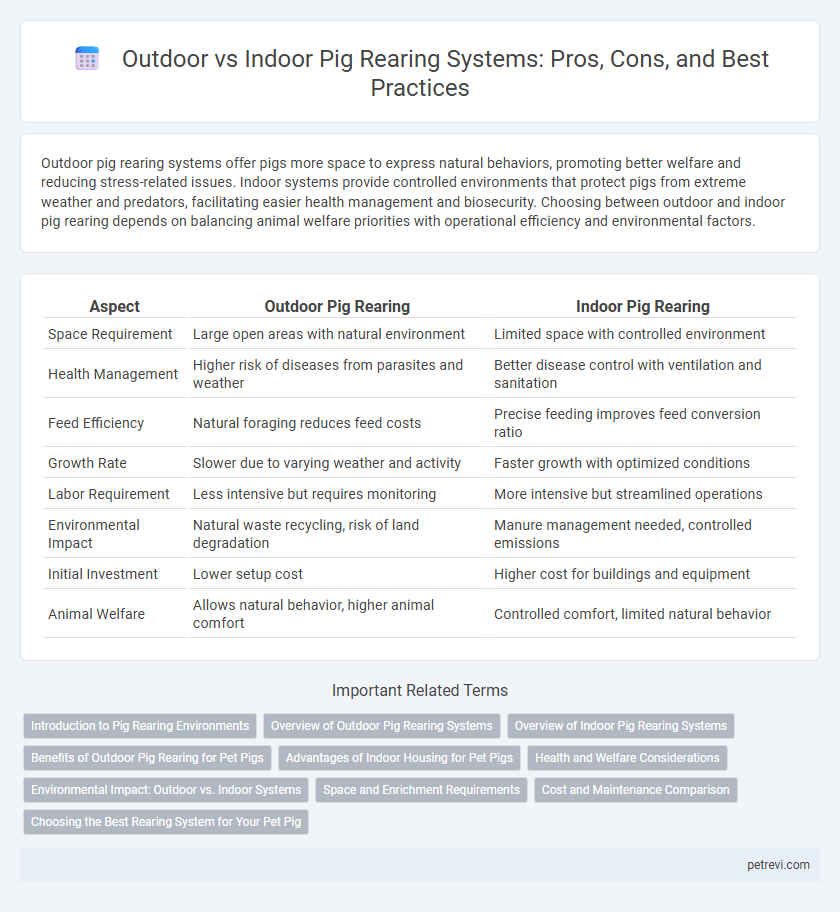Outdoor pig rearing systems offer pigs more space to express natural behaviors, promoting better welfare and reducing stress-related issues. Indoor systems provide controlled environments that protect pigs from extreme weather and predators, facilitating easier health management and biosecurity. Choosing between outdoor and indoor pig rearing depends on balancing animal welfare priorities with operational efficiency and environmental factors.
Table of Comparison
| Aspect | Outdoor Pig Rearing | Indoor Pig Rearing |
|---|---|---|
| Space Requirement | Large open areas with natural environment | Limited space with controlled environment |
| Health Management | Higher risk of diseases from parasites and weather | Better disease control with ventilation and sanitation |
| Feed Efficiency | Natural foraging reduces feed costs | Precise feeding improves feed conversion ratio |
| Growth Rate | Slower due to varying weather and activity | Faster growth with optimized conditions |
| Labor Requirement | Less intensive but requires monitoring | More intensive but streamlined operations |
| Environmental Impact | Natural waste recycling, risk of land degradation | Manure management needed, controlled emissions |
| Initial Investment | Lower setup cost | Higher cost for buildings and equipment |
| Animal Welfare | Allows natural behavior, higher animal comfort | Controlled comfort, limited natural behavior |
Introduction to Pig Rearing Environments
Pig rearing environments significantly impact animal welfare, growth rates, and disease control, with outdoor systems offering natural behaviors and better air quality, while indoor systems provide controlled temperature and protection from predators. Outdoor pig rearing involves pasture-based settings allowing rooting and foraging, promoting physical activity and mental stimulation. Indoor systems rely on ventilation, temperature regulation, and hygiene protocols to optimize health and productivity in confined spaces.
Overview of Outdoor Pig Rearing Systems
Outdoor pig rearing systems utilize natural environments with access to pasture, soil, and fresh air, promoting animal welfare and natural behaviors. These systems reduce the need for intensive feed inputs by allowing pigs to forage, which can improve meat quality and flavor profiles. Challenges include managing environmental impact, biosecurity risks, and variable weather conditions affecting pig health and growth rates.
Overview of Indoor Pig Rearing Systems
Indoor pig rearing systems provide controlled environments that optimize temperature, humidity, and ventilation to enhance pig health and growth rates. These systems utilize advanced technology such as automated feeding, waste management, and biosecurity measures to reduce disease risk and improve productivity. Indoor facilities also enable year-round production with consistent monitoring, leading to better feed conversion ratios and overall animal welfare compared to outdoor systems.
Benefits of Outdoor Pig Rearing for Pet Pigs
Outdoor pig rearing for pet pigs promotes natural behavior, improved exercise, and stronger immune systems due to exposure to fresh air and sunlight. This system reduces stress and the risk of respiratory diseases commonly found in confined indoor conditions. Enhanced space and environmental enrichment in outdoor setups contribute to better overall welfare and longevity in pet pigs.
Advantages of Indoor Housing for Pet Pigs
Indoor housing for pet pigs offers precise climate control, ensuring consistent temperature and humidity levels that enhance pig health and comfort. It reduces exposure to parasites, predators, and harsh weather, minimizing stress and disease risk. Controlled indoor environments also facilitate easier monitoring, feeding, and hygiene management, promoting optimal growth and well-being.
Health and Welfare Considerations
Outdoor pig rearing systems promote natural behaviors, improved air quality, and reduced disease transmission due to better ventilation and space, which enhances overall animal welfare. Indoor systems allow for controlled environments, minimizing exposure to harsh weather and predators but may increase risks of respiratory problems and stress from confinement and limited movement. Optimal pig health and welfare depend on balancing environmental control with opportunities for natural behavior expression and proper hygiene management.
Environmental Impact: Outdoor vs. Indoor Systems
Outdoor pig rearing systems typically have a lower carbon footprint due to natural waste recycling and reduced energy consumption compared to indoor systems, which rely heavily on mechanical ventilation and waste treatment. However, outdoor systems risk soil and water contamination from manure runoff if not managed properly, while indoor systems contain waste more effectively but produce concentrated ammonia emissions impacting local air quality. Effective environmental management in pig farming requires balancing these trade-offs by implementing best practices such as rotational grazing for outdoor pigs and advanced biofiltration in indoor facilities.
Space and Enrichment Requirements
Outdoor pig rearing systems require significantly more space per animal, typically 2 to 4 square meters, allowing natural behaviors like rooting and foraging, which fulfill enrichment needs and promote welfare. Indoor systems often provide limited space, around 0.65 to 1 square meter per pig, necessitating artificial enrichment such as straw bedding or toys to reduce stress and prevent stereotypic behaviors. Optimal pig welfare depends on ensuring sufficient space and enrichment tailored to the rearing environment, with outdoor systems naturally supporting behavioral health.
Cost and Maintenance Comparison
Outdoor pig rearing systems often involve higher initial costs due to infrastructure like fencing and shelters but benefit from lower ongoing expenses related to ventilation and waste disposal compared to indoor systems. Indoor pig rearing requires significant investment in controlled environment equipment such as heating, cooling, and automated feeding systems, increasing both capital and maintenance costs. While outdoor setups demand more labor for pasture management and predator control, indoor systems incur consistent energy costs and equipment upkeep to maintain optimal pig health and growth conditions.
Choosing the Best Rearing System for Your Pet Pig
Outdoor pig rearing systems offer natural foraging opportunities, improved exercise, and enhanced animal welfare, making them ideal for pet pigs requiring a more stimulating environment. Indoor systems provide controlled temperature, protection from predators, and easier waste management, suitable for pet pigs in urban or adverse climates. Evaluating factors such as available space, climate conditions, and your pig's behavioral needs is essential to choosing the best rearing system that promotes health and happiness.
Outdoor vs Indoor for Pig Rearing System Infographic

 petrevi.com
petrevi.com